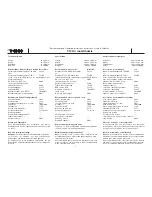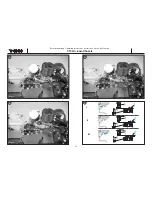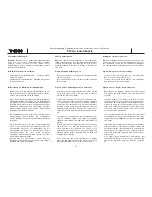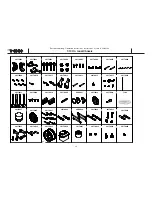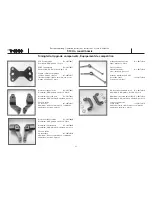
17
Betriebsanleitung, Operating instructions instructions, Notice d’utilisation
1:10 On road-Chassis
Bilder 25 und 26
- Springt der Motor noch nicht an: Glühkerze heraus-
schrauben. Stecker auf Glühkerze aufsetzen, die
Wendel muss rotglühend werden - siehe Pfeil. Wenn die
Kerze nur schwach glüht, Akku laden. Glüht die Kerze
nicht, diese ersetzen. Glühkerze einschrauben.
- Startvorgang wiederholen.
Bild 27
- Der Motor muss nun mit geringer Drehzahl im Leerlauf
durchlaufen. Wenn der Leerlauf zu hoch ist, die
Leerlauf-Anschlagschraube „L“ gegen den
Uhrzeigersinn in kleinen Schritten herausdrehen.
- Wenn der Motor stehen bleibt, ist der Leerlauf zu nied-
rig. In diesem Fall die Leerlauf-Anschlagschraube „L“
im Uhrzeigersinn hineindrehen.
Bild 28
- Der Leerlauf sollte nach dem Einlaufen immer so tief
wie möglich einreguliert sein, ohne dass der Motor ste-
hen bleibt.
- Der Motor muss mit einem „fetten Gemisch einlaufen,
d.h. bei mäßiger Drehzahl und deutlicher
Rauchentwicklung aus dem Schalldämpfer.
- „Fettes“ Gemisch wird durch schrittweises
Herausdrehen der Hauptdüsennadel „HD“ erreicht.
- Ein neuer Motor muss erst mit ca. 5 Tankfüllungen ein-
laufen, bevor er seine volle Leistung abgeben kann.
Zwischen den Einlaufperioden den Motor immer gut
abkühlen lassen.
- Um den Motor sofort zu belasten, auf einem ebenen
Untergrund die ersten Runden drehen.
- Nach dem Einlaufen die Leistung dadurch steigern,
dass die Hauptdüsennadel schrittweise im
Uhrzeigersinn hineingedreht wird.
- Die Hauptdüsennadel ist richtig eingestellt, wenn der
Motor seine höchste Drehzahl erreicht, ohne stehen zu
bleiben. Wenn der Motor stoppt und sehr heiß wird
(Gemisch zu „mager“), die Hauptdüsennadel ein wenig
herausdrehen.
- Zum Abstellen des Motors den Gasknüppel in
Leerlaufstellung bringen und den Schalldämpferauslaß
kurz verschließen (Lappen).
Figs. 25 and 26
- If the motor still does not start: unscrew the glowplug
and push it into the glow driver. The filament should
now glow bright red - see arrow. If the plug only glows
weakly, recharge the glow driver battery. If the filament
does not glow at all, replace the plug. Re-install the glo-
wplug.
- Repeat the starting procedure.
Fig. 27
- The motor should now run steadily at a low (idle) speed.
If the idle speed is too high, unscrew the idle stop screw
„L“ (anti-clockwise) in very small increments.
- If the motor stops, the idle speed is too low. In this case
screw in the idle stop screw „L“ (clockwise) slightly.
Fig. 28
- The idle speed should be set as low as possible with-
out any tendency for the motor to cut (stop), but final
adjustment is only possible once the motor is properly
run-in.
- The motor must be run-in using a „rich“ mixture, i.e. at
moderate speed and with a distinctly smoky exhaust
plume from the silencer.
- A „rich“ mixture is achieved by unscrewing the main
needle valve „HD“ in small increments.
- The new motor has to be run-in for about five comple-
te tankfuls of fuel before it is capable of producing full
power. Allow the motor to cool down thoroughly bet-
ween runs.
- The motor should be given a light „load“ even when
running-in, so place the model on an even surface and
drive it around gently.
- Once the motor is run-in you can increase its power by
screwing in the main needle valve (clockwise) in small
increments.
- The main needle is correctly set when the motor rea-
ches maximum speed without any tendency to cut. If
the motor stops and is obviously very hot, the mixture
is too „lean“: unscrew the main needle slightly.
- To stop the motor: move the throttle stick to the idle
position and hold a rag over the silencer outlet briefly.
Figures 25 et 26
- Si le moteur ne démarre pas : dévisser la bougie. Installer
le soquet sur la bougie, le filament de la bougie doit deve-
nir incandescent - Cf. flèche. Si l’incandescence du fila-
ment est trop faible, charger l’accu. Si le filament ne rougit
pas du tout, remplacer la bougie. Remettre la bougie en
place.
- Reprendre la procédure de démarrage.
Fig. 27
- Le moteur doit tourner maintenant sans faillir à faible régi-
me. Si le régime du ralenti est trop élevé, dévisser la vis de
butée du ralenti “L” dans le sens contraire des aiguilles
d’une montre, en procédant par petites étapes.
- Lorsque le moteur cale, le régime du ralenti est insuffisant.
Dans ce cas, il faut serrer la vis de butée du ralenti “L” dans
le sens des aiguilles d’une montre.
Fig. 28
- Un fois le moteur rodé, il faut que le régime du ralenti soit
toujours réglé le plus bas possible sans toutefois que le
moteur cale.
- Le moteur doit tourner au cours du rodage avec un “mélan-
ge gras, c’est-à-dire qu’à bas régime, les gaz d’échappe-
ment doivent être importants (fumée) au niveau du silen-
cieux.
- Le mélange “gras” est obtenu en desserrant par étapes, le
pointeau du gicleur principal “HD”.
- Roder d’abord un moteur neuf avec approximativement 5
pleins du réservoir, ce n’est qu’après cela que le moteur
sera en mesure de fournir toute sa puissance. Entre les dif-
férents pleins de rodage, laisser systématiquement refroidir
complètement le moteur.
- Pour charger immédiatement le moteur, effectuer les pre-
mières rondes avec le modèle sur une piste parfaitement
plane.
- Après le rodage, augmenter la puissance du moteur en ser-
rant progressivement le pointeau du gicleur principal dans
le sens des aiguilles d’une montre.
- Le pointeau du gicleur principal est parfaitement réglé lor-
sque le moteur atteint des régimes élevés sans caler.
Lorsque le moteur cale ou devient très chaud (le mélange
est trop maigre), desserrer légèrement le pointeau du
gicleur principal. Pour couper le moteur, amener le manche
des gaz au ralenti et boucher brièvement la sortie du pot
d’échappement (avec un chiffon par exemple).
Содержание S3003
Страница 1: ...1 10 On road Chassis Betriebsanleitung Operating instructions Notice d utilisation...
Страница 13: ...Betriebsanleitung Operating instructions instructions Notice d utilisation 1 10 On road Chassis 21 22 14 23 24...
Страница 17: ...Betriebsanleitung Operating instructions instructions Notice d utilisation 1 10 On road Chassis 18 30 29 31...
Страница 19: ...Betriebsanleitung Operating instructions instructions Notice d utilisation 1 10 On road Chassis 20 32 33 1 2 3...

